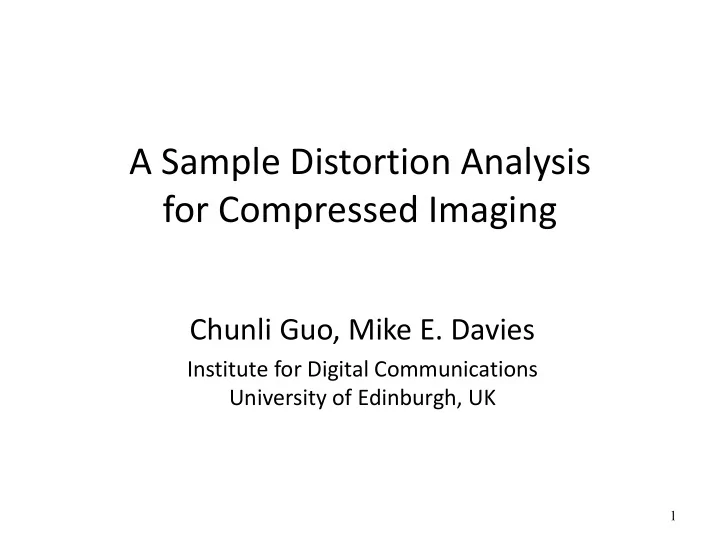

A Sample Distortion Analysis for Compressed Imaging Chunli Guo, Mike E. Davies Institute for Digital Communications University of Edinburgh, UK 1
Talk Outline • Introduction • Compressed Sensing: from Sparse to Compressible, from Deterministic to Stochastic • Sample Distortion (SD) framework • definition, examples, lower bounds and convexity • Multi-resolution CS • Wavelet Statistical Image Model • SD and Optimal Bandwise Sampling • Oracle Bounds • Sample Allocation with tree structure • Natural Image Examples • Conclusions 2
Sparsity and Compressed Sensing 3
Compressed sensing Compressed Sensing assumes a Set of signals of sparse/compressible set of signals interest Uses random projections for observation matrices Signal reconstruction by a nonlinear mapping. Compressed sensing provides nonlinear approximation practical algorithms with guaranteed random projection (reconstruction) performance e.g. L1 min., OMP, (observation) CoSaMP, IHT. Closely linked with theory of n- widths
The L1 solution guarantee
Compressible vectors (deterministic)
Compressible Distributions
A Sample-Distortion framework for CS
Sample Distortion Framework [Guo & D. 2011/2012]
Sample Distortion Framework 10
SD Functions for 2-state GSM ( ) 0.38 (0,1.198) 0.62 (0,0.0044) p x N N ( ) 0.38 (0,1.198) 0.62 (0,0.0044) p x N N Convexity implies achievable (by zeroing) BAMP SD fun BAMP SD fun MBB EBB 11
SD Lower Bounds 12
Example: Generalized Gaussian Gaussian EBB Laplace EBB GGD, α =0.4 EBB Wavelet coefficients of natural images are often modelled as GGD with α ≈ 0.4 -1.0
SD Lower Bounds 14
Convexity of D( δ ) Theorem: The SD function, D( δ ), is convex Convex hull achievable by , combinations of and , 1 1 1 1 D , 1 D 2 2 3 , 2 2 D 2 1 3 2 15
Gaussian encoders are not optimal! Folk theorem - Gaussian encoders are optimal. False ! If Gaussian-specific SD function is not convex we can do better 16
SD Functions for 2-state GSM ( ) 0.38 (0,1.198) 0.62 (0,0.0044) p x N N Convexity implies achievable (by zeroing) BAMP SD fun MBB EBB 17
Multi-resolution Compressive Imaging
Statistical image model 19
Test Images
Image model example cameraman
Image model example GGD representation with Haar wavelets... Estimated shape parameters for each level cameraman
Image model example GGD wavelet representation Estimation of the variance for each level e.g. cameraman
Bandwise Compressive Imaging
Bandwise sampling
Optimal Bandwise sample allocation
Bandwise Sampling Convexified MMSE AMP distortion reduction function (band 1 for cameraman image model) distortion reduction distortion 27
Bandwise Sample Allocation DR fun for cameraman image 28
Bandwise CS sample allocation Sample allocation (% of full sampling) per band for m = 170, 600, 2000 and 10000 measurements. There are typically no more than 2-3 partially sampled bands
Bandwise CS Performance e.g. cameraman 30
adding Tree Structure
Incorporating Tree Structure We can add tree-based priors on coefficients and decode using Turbo AMP scheme [Som, Schniter 2012]: This calculates marginal probabilities for hidden states and incorporate into MMSE AMP 32
Bandwise CS Sample Allocation Sample allocation (% of full sampling) per band for δ= 10%, 15.26%, 25% and 30% m=1000 m=6554 SA for cvx SD fun Empirical best SA m=19661 with tree info m=16384 SA for SD fun with oracle tree info 33
Bandwise CS Performance e.g. cameraman 34
Reconstructed I Image reconstructions from 10000 measurements (15%) 35
SA for General Image Statistics 36
Open questions • How to derive sample allocations for more sophisticated models? – analysis representations, tree structured model, etc. • How to allocate samples within constrained sampling schemes (e.g. partial Fourier)? 37
References • R. Gribonval, V. Cevher, and M. E. Davies. Compressible Distributions for High-dimensional Statistics. Preprint, 2011, available at arXiv:1102.1249v2. • M. E. Davies and C. Guo, Sample-Distortion Functions for Compressed Sensing , 49th Allerton Conf. on Communication, Control, and Computing, 2011. • C. Guo and M. E. Davies , Sample-Distortion for Compressed Imaging , on IEEE TSP, 2013.
Thank You 39
Recommend
More recommend